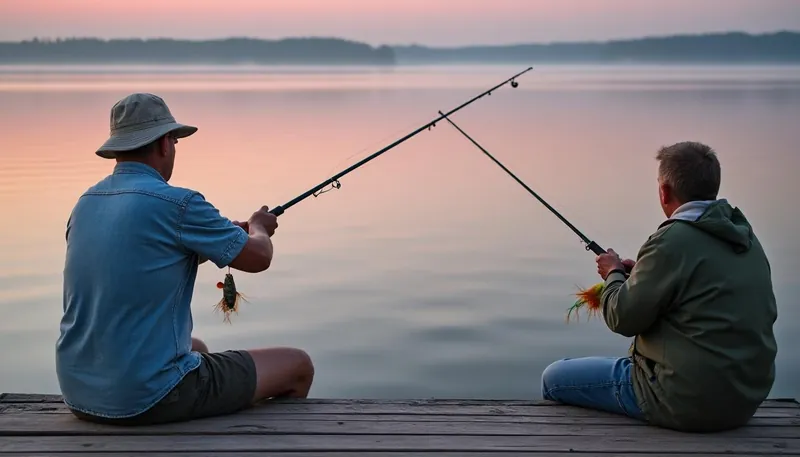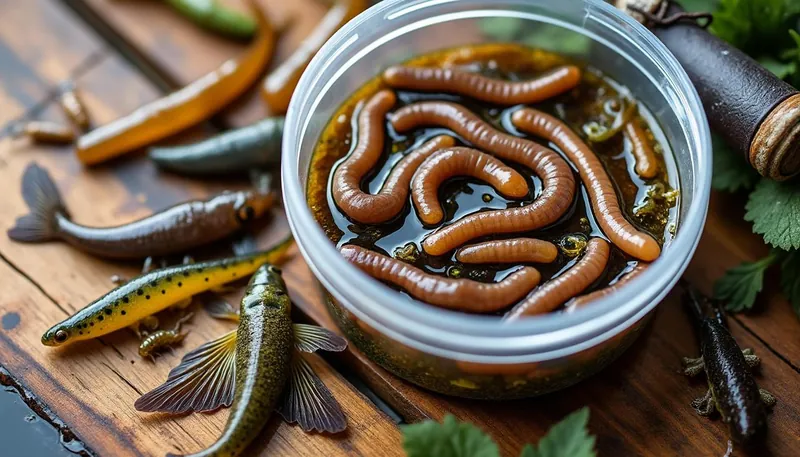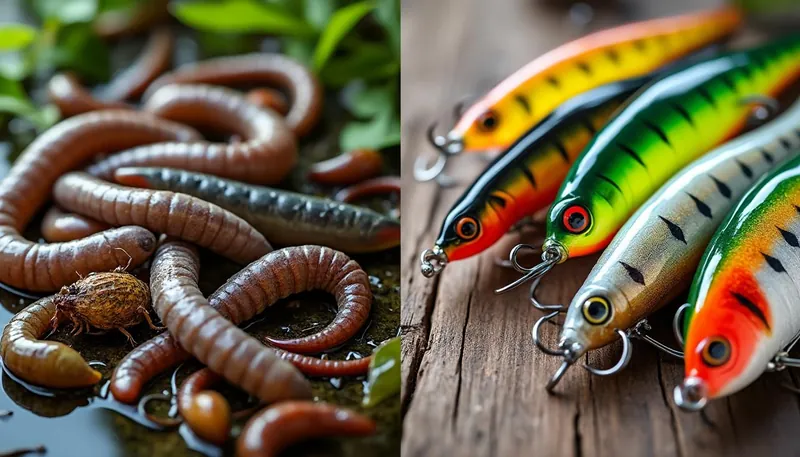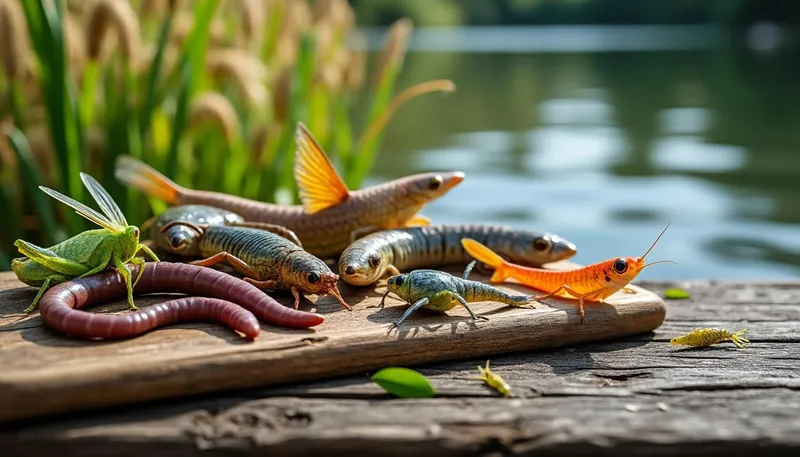When it comes to fishing, the debate between using live bait and artificial lures has been a longstanding conversation among anglers. With each camp promoting its own virtues and gameplay, deciding which one to use can feel like choosing sides in an age-old rivalry. Right from beginners to seasoned pros, everyone has their arguments lined up. Some swear by the smell and movement of a real fish, while others believe that the clever artistry of lures can outsmart the most astute trout. This article will delve into the nuances of live bait versus artificial lures, exploring their respective pros and cons, ideal usage scenarios, target species, fishing strategies, and economic implications. Let’s get our feet wet, shall we?
Brief:
- Fishing with live bait is favored for its natural appeal and attractiveness to various fish species. 🎣
- Artificial lures allow for creativity and can be tailored to specific fishing techniques, but often require more skill to master. 🪝
- Choosing between live bait and lures depends on environmental conditions, target fish, and personal preferences. 🤔
- Both options range widely in cost, with live bait often being more economical in the long run. 💰
- The effectiveness of each method can often depend on factors like visibility, water conditions, and the time of year. 🌦️

Understanding Live Bait and Artificial Lures
Let’s start by defining live bait and artificial lures. Live bait usually comprises natural organisms like worms, minnows, and insects used to attract fish by mimicking their standard food. This method relies on the natural scent, appearance, and movements of live creatures to entice fish into biting. On the flip side, artificial lures are man-made baits designed to imitate the look and behavior of live prey. They come in countless shapes, colors, and materials, aimed at triggering a fish’s instinct to chase and capture. While both methods have their advantages, they yield different outcomes under various circumstances.
Types of Live Bait
Freshwater fishermen often have a plethora of live bait options. Here are a few popular types:
- Minnows ➡️ Small fish that attract larger predators
- Night Crawlers ➡️ Great for a variety of fish and easy to find 🌍
- Crickets ➡️ Perfect for panfish during warmer months
- Leeches ➡️ Effective for many species, especially during spawning season
On the other hand, larger baits can be used for bigger game fish; these include shiners, frogs, or even small fish like bluegill. If you’re angling for bass, for instance, a live crawfish or small bluegill can offer an enticing meal that frequently results in a successful catch.

Types of Artificial Lures
There’s no shortage of artificial lures available; they come in numerous designs tailored for different fishing styles. Some widely used types include:
- Spinner Baits ➡️ Great for mimicking shad and adding splash to the water 🌊
- Crank Baits ➡️ Ideal for deeper fishing and targeting bass
- Soft Plastics ➡️ Versatile, they look, feel, and move like real prey
- Top-Water Baits ➡️ Visual bait that can generate exciting strikes on the surface
- Jigs ➡️ Effective for bottom fishing and enticing larger species
Each lure has unique characteristics and a specific application, providing anglers with the opportunity to tailor their approach to the environment and target fish. The creativity involved in selecting, using, and possibly modifying these lures adds a level of enjoyment that many anglers find appealing.
Pros and Cons of Live Bait
Fishing with live bait can feel like a sure thing, given its natural appeal. Here are some of the pros:
- 🔍 Natural Forage: Fish are drawn to live bait because they recognize it as a food source.
- 🐟 Multi-Species Appeal: It can attract a wide range of fish species, making it ideal for versatile fishing trips.
- 💰 Cost-Effective: Especially if you’re foraging your bait, costs can be minimal in the long run.
- 🌱 Eco-Friendly: Any unused live bait can be released back into the environment.
However, fishing with live bait also has its downsides:
- 🧊 Care Required: Bait needs aeration or refrigeration to remain lively and appealing.
- 🥴 Messy Business: There can be unpleasant odors and handling involved with live bait.
- 🦠 Unwanted Catch: You may catch fish that aren’t on your target list.
- ⏳ Limited Use: Once you run out of bait, your fishing day can be essentially over.
These pros and cons encourage anglers to consider what works best for their fishing style, depending on their preferences and expected outcomes.
| Pros of Live Bait | Cons of Live Bait |
|---|---|
| 🔍 Natural foraging appeal | 🧊 Needs proper care |
| 🐟 Multi-target suitability | 🥴 Can be messy |
| 💰 Cost-efficient if foraged | 🦠 Unwanted catches possible |
| 🌱 Eco-friendly disposal | ⏳ Limited lifespan |
Pros and Cons of Artificial Lures
Artificial lures come with an array of advantages that can elevate your fishing experience:
- 🎨 Colorful Variety: The different colors and designs available can be appealing and fun to collect!
- 🚀 Interactive Experience: You actively control the action while using lures, making fishing more engaging.
- 💼 Lightweight Storage: Tackle boxes can easily accommodate many lures without added weight.
- 🌊 Covers More Water: Lures allow for efficient movement across larger areas, helping find fish more quickly.
That said, using artificial lures isn’t without its challenges:
- 🤑 Costs Add Up: Lures can be pricey, especially if you’re tempted to try out every new model.
- 🔍 Trial and Error: You may spend time figuring out which lure works best in particular conditions.
- ⚠️ Snag Potential: Lures can sometimes get caught in structures, resulting in losses.
- 💪 Physical Demand: Active fishing with lures often requires constant casting and reeling.
The dynamics of lures versus live bait will depend not only on personal preferences for engagement but environmental conditions as well.
| Pros of Artificial Lures | Cons of Artificial Lures |
|---|---|
| 🎨 Wide variety of choices | 🤑 Potentially high costs |
| 🚀 Interactive and engaging | 🔍 May require trial and error |
| 💼 Easy to store | ⚠️ Risk of snagging |
| 🌊 Good for covering distance | 💪 Physically demanding |
Choosing When to Use Live Bait vs. Lures
Ever thought about when you’d be better off with live bait or artificial lures? Here’s a handy breakdown:
When to Use Live Bait:
- 🌀 Murky Water: In muddy conditions, the scent is your ally!
- 🌒 Nighttime Fishing: Fish are less likely to see the lure but can feel and smell live bait.
- ❄️ Cold Weather: In colder climates, fish are less active, and real movement can be crucial.
- 🍽️ For Dinner: If you’re looking to catch a meal, live bait is often more reliable.
When to Use Artificial Lures:
- ☀️ Warm Weather: Active fish are easier to lure with vibrant colors concentrating on reflex strikes.
- 💧 Clear Water: Visual prowess allows lures to shine in bright water conditions.
- 🎯 Specific Species: For targeting aggressive predatory species, lures often work better.
- 📍 « Artificial Only » Areas: Follow local regulations; they’ll often note when only lures can be used.
Target Species for Bait and Lures
The target fish species will significantly influence your choice between live bait and artificial lures. Here’s how:
Live Bait is effective for:
- 🐟 Panfish: (bluegill, crappie) react well to live worms and insects.
- 🐠 Catfish: Often attracted to strong-smelling live bait like cut bait or worms.
- 🌾 Carp: Interested in natural vegetation or worms on the hook.
Artificial Lures are perfect for:
- 🎣 Bass: Effective with top-water lures when they’re feeding aggressively.
- ⚔️ Walleye and Pike: Hard baits and spoons often trigger aggressive strikes.
- 🦈 Saltwater Species: Many saltwater fish find lures like jigs or spoons irresistible.
| Species | Preferred Bait/Lure |
|---|---|
| Panfish | Live Worms |
| Catfish | Strong-smelling Live Bait |
| Carp | Worms |
| Bass | Top-water Lures |
| Walleye | Hard Baits |
Costs Involved with Live Bait vs. Artificial Lures
All anglers need to consider their budget; that’s a practical aspect of fishing too. When we talk about costs:
| Expense Category | Live Bait | Artificial Lures |
|---|---|---|
| Initial Cost | 🌿 Free if Foraged | 💲 $1.99 to $70+ each |
| Ongoing Costs | 🧊 Bait Maintenance Supplies | 💵 Replacement over time |
| Environmental Cost | ♻️ Can be recycled back into nature | 🚫 Often spent and lost |
As you can see, live bait can be much more affordable over time if you are diligent, while artificial lures can require initial investment that accumulates. Regardless of the bait you choose, managing expenses is key to a rewarding fishing experience.
What type of fishing is best for beginners, live bait or lures?
Beginners often find success with live bait due to its natural appeal, which helps in attracting a broad variety of fish.
Can you mix live bait and artificial lures?
Yes, combining both approaches can be effective, especially in distinguishing your offerings in the water.
Are there specific fish that favor live bait?
Yes! Species such as catfish, panfish, and carp are often more attracted to live bait than to lures.
What are the environmental impacts of using live bait?
When properly used, live bait can be eco-friendly as leftovers can be disposed of without harm, though care should be taken not to introduce invasive species.
Do certain times of year favor one type of bait over the other?
Yes, for example, warm weather often favors artificial lures, while colder temperatures might see more benefits from live bait.

